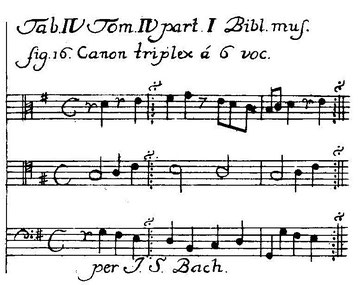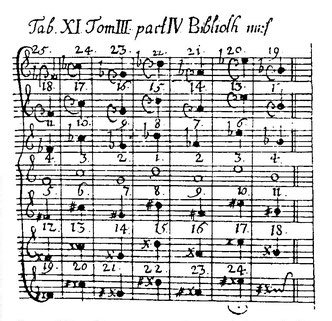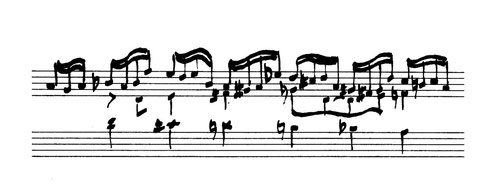Inter Nationes englisch
Kulturchronik 2/1992
Cultural Excavation
Co-operation between Telemann, Bach and Handel
by Evelyn JL Puefken
"Who would have imagined that in these few notes were hidden a thread which, like a short, thick, golden wire, could be extended to a hundred times its length?" - asked Johann Mattheson (1681 - 1764), musicologist and composer, in his work "Der vollkommene Kapellmeister" ("The Perfect Conductor", 1739) with regard to the one and a quarter bars of music from a composition by his colleague George Frideric Handel - and left the riddle unsolved.

What if the key to that "golden thread" had been found? And what if that strange story applies not just to those bars but even to all of Handel's scores?
"But whosoever examines them throughout must recognize the composer as a miracle..." (John Mainwaring: Memoirs of the Life of the late G.F. Handel, 1760 - translated into German by J. Mattheson, 1761).

Composer Helmut M. Timpelan, born in 1937, has taken those indications in the writings of Mattheson and Mainwaring literally. He started investigating Handel’s scores “through and through”. In so doing in 1985 he not only hit upon a hitherto unkown and forward-looking Handel, but following that “golden thread” he uncovered a constellation unique in musical history. His discovery: composers George Frideric Handel (1685 – 1759), Johann Sebastian Bach (1685 – 1750) and Georg Philipp Telemann (1681 – 1767) had worked together both on a shared programme and in terms of composition technique.
How did Timpelan make this discovery? It started with the deciphering of the three bass lines in the mysterious Canon triplex à 6 Voc. Per J.S. Bach which in the Haußmann portrait (1746/47) the composer holds towards the observer. The fact that the bass part was to be found in Handel’s works as “Chaconne Bass” had long been known by experts, but did not affect evaluations of Handel. However, the discovery that the other two parts came from Handel’s works for harpsichord, and that the middle part even corresponds to the golden thread mentioned by Mattheson, led the Stuttgarter Zeitung to publish an article marking the 300th anniversary of Bach’s birth – “Seek and Ye Shall Find: Bach and Handel as Partners in Dialogue” by Horst Koegler, 21.3.1985) – devoted to what the newspaper called Timpelan’s “sensational discovery marking the Bach Year”. (See also the reprinting by Inter Nationes in Kulturchronik 4/85).
Tracing back those three voices provided Timpelan with the key to a veritable goldmine in Handel’s keyboard works. The quotation of one and a quarter bars from the fugue in the second of the “8 Harpsichord Suites” Handel had dedicated to the English nation in 1720 was only one out of innumerable examples of “golden threads” hidden there.
Those keyboard works – up to the present day underestimated as “a feeble assemblage of finger exercises, antiquated suites, and sloppily-worked fugues” – turned out to be a rich source of unsuspected structural elements. When these scores were read in conjunction with Bach’s works for organ and harpsichord, they revealed to Timpelan the miracle of Handel’s compositional technique. Without exception they were written in ongoing multiple counterpoint. Handel’s designation is “Evolutio”, which signifies that the parts are disposed in such a way that they can be interchanged at will, thereby giving rise to new harmonies. Anyone who knows a little about counterpoint will know what that signifies. And people who have read about musicologists’ separation of Handel and Bach as musical masters will prick up their ears on hearing the abundance of identical, highly complex processes of the compositional technique, such as canons, subjects and countersubjects, and intricate harmonic procedures.
Bach’s fully elaborated and self-contained scores in turn served Timpelan as a guideline in elucidating the formulae employed by Handel and Telemann.

In 1986 Timpelan also discovered Handel’s exemplary “golden thread” in Georg Philipp Telemann, the composer who viewed himself as a “mediator” and, as is well known, was closely linked with Bach and Handel. This occurs in his Psalm 118, which includes the words: “The stone which the builders refused is become the head stone of the corner”… (verse 22). So is Telemann the third member of an alliance?
Timpelan searched – and continued to make discoveries. Under the new aspect of a reciprocal creative dependency in the works of Handel and Bach, Telemann suddenly took on unexpected weight and topicality as both composer and – even more – author of pedagogic and didactic works. These include the 1733/34 Exercises in Singing, Playing and Continuo where Telemann implicitly defends Bach’s rule-breaking part-writing and the harmonic consequences which endow the music with its specifically “Bachian character” – and also his New Musical System (1752). There he as good as explains the shared foundation of co-operation between Telemann, Bach and Handel: The perpetual canon.

“Canon” signifies: rule, principle, guideline, regularity. The cyclical canon is the highest level of this genre. Without beginning, without end, eternal: “Canon perpetuus”. Harmony as ideal relationship between dissimilar parts: in this case, consonance and dissonance.
Each canon constitutes an autonomous universe with infinite possibilities of change. In addition, a harmonically organized chain of canons can become a whole with a beginning and an end within “a unified combination of diverse elements” – in other words, a com-position.
Indispensable for such a com-position is knowledge of application of the “golden section” in music with the “cut” both separating and ordering.
Timpelan has long put this to the test in Handel’ s keyboard works, which – as already indicated – embody a systematically devised sequence of component parts. The outcome: new music – cyclical canons with between two and seven parts. He calls these “demonstration canons”, and they supply concrete evidence as music which is anything but “baroque”, and of a strange, unfamiliar beauty, uniting for the first time Bach’s density and Handel’s spaciousness (also see Walther Siegmund-Schultze: Two Geniuses as the Model, Stuttgarter Zeitung, 9.8.1985). These pieces were performed at the Freiburger Goethe Institute as early as 1986, accompanied by the premiere of the completely restructured “Canon triplex” employing retrograde and mirror forms (where the musical intervals are horizontally reversed).

The restructuring processes employed are by no means artificial. “The rules applying to sight and hearing are one and the same… Relationships between notes are registered on the ear drum in a miniaturised and inverted form…” wrote doctor, mathematician and musicologist Lorenz Mizler (1711-1778) in his 1742 published annotations on the Gradus as parnassum by Johann J. Fux (1660-1741). Recognizing that “a man’s life is not sufficient” for uncovering the natural laws of music, in 1738 he established at Leipzig the Corresponding Society of Musical Sciences, which in1755 (the year the Society disbanded) was also to be joined by Leopold Mozart (1719-1787), father of Wolfgang Amadé (1756-1791).
Attention must be drawn to that Society here – despite its considerable internal upheavals -because, firstly, Telemann, Bach and Handel were members (the latter an honorary member);
Secondly, Bach’s already mentioned Canon triplex (1754) was published in Mizler’s Newly Opened Musical Library or Comprehensive Information on and Unbiased Assessment of Old and New Musical Books and Writings (1736-1755); and thirdly, so too was Telemann’s Musical System (1752).

With regard to Telemann’s New Musical System – actually an unremarked mystery canon – musical experts both then and now have demonstrated a similar lack of understanding. The work was sent from member to member over the course of nine years until its author was finally asked to explain his system in person.
“I am requested to set forth the advantages of this system. I would prefer, however, that it might be discovered on its own account… But people ask this of me. So I must…” The otherwise not exactly taciturn composer needed an invitation. Remarkable! Seemingly willingly, but in his own way, he explains the “sounds, notes, intervals”, whose names – as he conceded elsewhere – may sound “somewhat comical” to his contemporary readers, but “to former times their qualities and characteristics were, however, certainly known ...”.
“§19… Harmony hereby gains a fair number of sounds hitherto thought unusable although they are indispensable…”. These would be by no means “spectres” from which one would have to “take flight”. And a pedagogic change of position à la Diderot: “Only a dozen or so years ago” even he himself “believed that one had to take the selling salts when listening to many of these harmonies. Only the experience” had made him “loose this error…”
It is easy to guess that Telemann’s discourse did not quite exactly fulfill Society members’ expectations of a “scholarly presentation”. Because instead of solving his mystery canon, he just posed even more riddles in his “explanations”. A final attempt by Mizler at “encouraging all connoisseurs to examine the New Telemann System more closely and wherever possible to make use of it” failed – and thus musicologists and the musical world put it “ad acta”.
For Telemann that was a setback he could certainly easily surmount (since Bach and Handel had long confirmed in practice the “usability” of his “diminished and augmented sounds” an his “intervals with fourfould position”!) [ Archiv 2 ] Timpelan, however, believes that this was a mistake with serious consequences for the musical world for almost the next 250 years…
As this lack of interest was not officially corrected, with this didactic work also an elementary, although quite strange looking sign of notation (Telemann calls it the “augmented Unisonus”) disappeared, and with its form and function also the hint at an important connecting link to the three masters (culminating in the years that followed in an explicit break between researchers into Bach and scholars concerned with Handel).
Also fell in oblivion a basically obvious trail leading from co-operation between those three masters to their sources, the origins of their musical crafts, which ultimately favored the cult of J.S. Bach as a lonely, mystical genius. In brief, a piece of German musical and Western cultural history was lost, the cultural heritage of many nations. Because: After all, who would doubt that there is a peculiar matter when three such prestigious and exceptional composers co-operated…
“This notation of the augmented Unisono is otherwise unusual… We , however, wanted to show that such a Unisonus really does exist” (Telemann in Exercises in Singing, Playing and Continuo). The existence in music of this really unusual figure (in the figuring of the continuo line) - similar to the Arabic number one with a diagonal bar – provided more than musical confirmation of Timpelan’s work: By pursuing traces of the still known (because usable) notation of the “Claves enharmonicae”, the “Claves diatonicae” and the “Claves chromaticae” (see Carl Faulmann: The Book of Writing, Vienna 1880, reprinted 1985, p. 78/79, tables on Canaanite and Aramaic/Samaritan writing), he deciphered the symbol he sought as “Yod” (Greek “Iota”). This is the tenth letter in Ancient Jewish cursive scripts and detailed research has shown that its characteristics and musical qualities are identical with those of Telemann’s “augmented Unisonus”.
“One jot or tittle of the law shall not escape…” – Everyone knows this proverbial phrase about the inflexibility of the law. The law, the rule, the canon is – as Timpelan discovered - an autonomous Old Aramaic system of 22 consonants with numerals, valences and a way of reading from right to left. The fact that this alphabet simultaneously embodies musical notation will also be comprehensible to laymen: Both in earlier times and today, notes have been given alphabetical designations in a number of cultures, including that of Germany. However, its now forgotten exceptional function could only be “re-excavated” through the decoding of Telemann’s musical theory. Its proportions serve as a musical measuring stick. (“My Latin mentor, the good Herr Calvor,… also showed me the relationship between measurement and music…” wrote Telemann of Caspar Calvor (1650-1725) in his autobiography of 1740).

If the Society members had not regarded the “New Musical System” and its “Yod” as “spectres” and had not “taken flight” from both the compositional practice and theory, Timpelan believes they could have learned there very much from Lesson 42, table XI. For instance:
- How the special characteristics and qualities of a sound and its dissemination, which “were certainly known to former times”, could be “employed” for withdrawal of music– through use of the yardstick of the Old Aramaic alphabet and its units of measurement, from the first to the twenty second and last letter;
- How the old Greek alphabet (also with 22 letters, numbers and musical values) relates to that in inversion; how the two alphabets lead to both a “Canon perpetuus” and also (as mediator of Orient and Occident in their characteristically contrary ways of reading) a “Canon cancricans” – “which can be simultaneously deployed from the beginning to the end or from the end to the beginning i.e. in reverse” (Johann Walther 1684-1748, composer and related to Bach, in the Musical Lexikon, 1732), just like Handel’s Chaconne Bass, foundation of Bach’s Canon triplex, is also organized as “retrogression”;
- And how the “Aleph” (cf. circle, acute angle) thereby forms the starting- and middle-point from which the sounds spread in spherical waves.
Then members could have realized how, by failing to appreciate that theory of music, they ultimately denied their own maxims whose programmatic emphasis, the cyclical canon, is after all manifested in their Society’s seal: “The circle that touches the three apexes of an equilateral triangle, incorporating the musical numbers 1, 2, 3, 4, 5 and 6, and around which bees fly, is the seal of the musical sciences, representing the Society’s endeavours to improve music by way of mathematics and worldly wisdom…”
However, they mistook knowledge for wisdom…
Composers G.F. Handel, J.S. Bach and G.P. Telemann could fulfill that Society’s high musical and ethical demands. They did not feel bound by the theoretical verbal wranglings of a rationalism that just was just establishing itself, but rather – completely practically and entirely conservatively in the sense of preserving the past – to the ancient law of wisdom with all of its musical implications, which at the same time pointed to the future.
“Soli Deo Gloria” wrote the three composers. Only in praise of the Highest. That found expression in their scores, in the fruits of a concentrated, lifelong musical tria-logue. As “logos” is not only the Word, but also wisdom and sound. “Every individual note is a sound” is discovered in Telemann. And in Bach: “The other reservations which one must apply will be more apparent in oral teachings than in writing…” And in the case of Handel? Golden threads, infinite golden threads.

 helmut m. timpelan
helmut m. timpelan